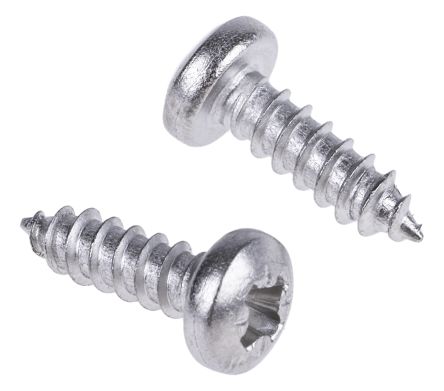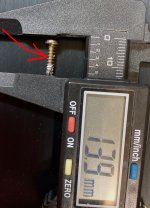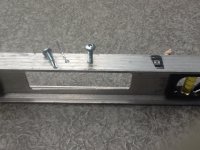What are these screws called and where can I get them? They are used in securing output transistors on heatsinks. They seem much more user friendly than the machine screws i have been using. Those need to be tapped, which sometimes ruins the sink plus takes a long time, These on the other hand are just drill and screw types, no need to tap them ... I know they are self tapping, but what kind or where can I order them?
Attachments
Sheet metal screw. You drill a hole somewhat less in diameter than the screw, and it cuts threads as you turn it.
https://www.homedepot.com/p/Everbil...el-Sheet-Metal-Screw-50-Pack-800162/204275035
Pilot-hole sizes:
size-4, 3/32 inches
size 6, 7/64 inches
size 8, 1/8 inches
https://www.homedepot.com/p/Everbil...el-Sheet-Metal-Screw-50-Pack-800162/204275035
Pilot-hole sizes:
size-4, 3/32 inches
size 6, 7/64 inches
size 8, 1/8 inches
Last edited:
Sheet metal screw. You drill a hole somewhat less in diameter than the screw, and it cuts threads as you turn it.
https://www.homedepot.com/p/Everbil...el-Sheet-Metal-Screw-50-Pack-800162/204275035
Not the same kind. The ones I photographed have larger threads, and are slotted. They are not home depot types.
All "sheet metal" screws are "self tapping" to a point because they are not constant diameter like a "mechanical screw" or "bolt" or plain "screw" intended for a pre threaded hole or nut, instead nthet "startb thinner" so they can oush metal/plastic/wood apatrt.
Easier to do on sheet metal because of not much metal being involved, so it´s relatively easy to push it aside and forming a coarse thread.
Now if sheet metal is thicker or material is not easy to push aside (it can crack) then, as in your example, tip is less "conical" but a slot is ground, so a sharp edge is formed, it can *cut* the base material instad of simply shoving it aside, now your self tapping screw becomes "self threading self tapping screw", it actually works like a built in screw tap.
These are called self tapping screws but they only work on sheet metal or relatively soft plastic (or wood):

In my book *these* are the real/full self tapping screws, notice they are way less "conical" (although always there is some taper) but they have a special tip where you have a material cutting edge:
Wikipedia distinguishes between them as:
First ones are cheaper and ubiquitous, material cutting ones are more specialized and somewhat harder to find.
Name alone can be confusing since lots of people call all the same, which they are not.
If you want to buy some, browse catalogs carefully and specify the right code.
Easier to do on sheet metal because of not much metal being involved, so it´s relatively easy to push it aside and forming a coarse thread.
Now if sheet metal is thicker or material is not easy to push aside (it can crack) then, as in your example, tip is less "conical" but a slot is ground, so a sharp edge is formed, it can *cut* the base material instad of simply shoving it aside, now your self tapping screw becomes "self threading self tapping screw", it actually works like a built in screw tap.
These are called self tapping screws but they only work on sheet metal or relatively soft plastic (or wood):

In my book *these* are the real/full self tapping screws, notice they are way less "conical" (although always there is some taper) but they have a special tip where you have a material cutting edge:
An externally hosted image should be here but it was not working when we last tested it.
Wikipedia distinguishes between them as:
Thread-forming vs. thread-cutting
Self-tapping screws can be divided into two classes;[3] those that displace material (especially plastic and thin metal sheets) without removing it are termed thread-forming self-tapping screws; self-tappers with sharp cutting surfaces that remove the material as they are inserted are termed thread-cutting.
First ones are cheaper and ubiquitous, material cutting ones are more specialized and somewhat harder to find.
Name alone can be confusing since lots of people call all the same, which they are not.
If you want to buy some, browse catalogs carefully and specify the right code.
Anything I find that is self threading, is #6-#8 or larger. I probably need something in the #3 or #4 width that will go through TO-220 cases.... Must be a specialty screw.
Anything I find that is self threading, is #6-#8 or larger. I probably need something in the #3 or #4 width that will go through TO-220 cases.... Must be a specialty screw.
Why don't you just learn how to tap aluminum for machine screws. Those self tapping sheet metal screws aren't the answer for thick aluminum. They will bind in the hole and snap off, and then you'll be really angry.
If you bugger a threaded hole, you can fix it with a thread repair kit.
jeff
Exactly, I question the premise of the thread. If you are talking about an open hole, just forget tapping and use a bolt and nut. If you are talking about a blind hole, tapping screws won't work, at least not as intended.
Aluminum is soft enough that a self tapper can work on a relatively thick piece. Try a few practise holes if you can. Aluminum dosnt really need a guide hole, a good self tapper should cut it like a drill bit. Done it many times myself.
Last edited:
Just remembered, your stuck with philips screw heads that dont hold worth a dam. Especially the small ones. You might have to tape the screw to the bit so it dosnt fall off from the pressure as its drilling. Or find some robertson heads.
It may seem counterintuitive, but aluminum is more difficult to tap. You have to back out and clean the tap. That's not how these screws are intended to be used. These screws are for quick 1 action driving.
Wrong. Thats exactly what there made for. Its a driil bit on the end of the screw. 1/8 inch aluminum, could have been a lot thicker. Look at the start of the hole where the aluminum is beeing drilled out. You dont have too back out to clean it.
Attachments
Last edited:
Hahaha thanks for saying I'm wrong and then attaching a picture where the backed out screw has pulled out an aluminum shaving.
Try reading what I said. Look closer. Thats not a backed out screw. The first hole is the start, the screw was not in yet, it was just started. I did that to show you what the screw did with the waste, it ejects it like a drill bit. The screw that's in went straight in with no back out. Why dont you try it?
- Home
- Design & Build
- Parts
- What are these screws called?

